Regionale 13
No man is an island
25.11.2012 —
6.1.2013
- Marie-Anne Baccichet
- Sarah Bernauer
- Gregory Buchert
- Ralph Bürgin
- Martin Chramosta
- Lorenza Diaz
- Jan Erbelding
- Delphine Gatinois
- Bianca Hildebrand
- Clare Kenny
- Jan Kiefer
- Antoine Lejolivet
- Oliver Minder
- Sebastian Mundwiler
- Natacha Paganelli
- Bianca Pedrina
- Philippe Reinau
- Marion Ritzmann
- Tom Senn
- Valentina Stieger
- Aline Zeltner
“No man is an island, entire of itself; every man is a piece of the continent, a part of the main. If a clod be washed away by the sea, Europe is the less, as well as if a promontory were, as well as if a manor of thy friend’s or of thine own were. Any man’s death diminishes me because I am involved in mankind; and therefore never send to know for whom the bell tolls; it tolls for thee.” (John Donne, Devotions Upon Emergent Occasions: Meditation XVII., 1624, quoted from The Works of John Donne, vol III, Henry Alford (Ed.), John W. Parker: London, 1839, p. 574—5)
“No man is an island” — this much quoted phrase of the English poet John Donne serves as a starting point for this year’s Regionale at Kunsthaus Baselland focusing on works by young artists from the region. Sabine Schaschl, director and curator, developed and curated the concept and the implementation of the exhibition along with art historian, educator and lecturer, Martina Siegwolf. Siegwolf is familiar with the Regionale since its inception and was also involved in the first Regionale.
This year Sabine Schaschl and Martina Siegwolf invited more than a dozen artists from the Basel region, supplemented by some artists’ items which have been selected from the submitted dossiers.
Among the most famous citations of “no man is an island” in popular culture are the books of the same title by Johannes Mario Simmel and Thomas Merton. Donne describes how each person is part of a whole and compares the washing away of a clod of earth with the loss of a person. Based on this early network concept, the exhibition at the Kunsthaus Baselland deals with the question how a young generation of artists work while they are involved in a ubiquitous communication and exchange structure in the age of social media and global networks. Basically, one can conform to this structure by becoming part of the network itself, or one can escape the ubiquity of communication by withdrawing to one’s ‘private island’. But even the latter is shaped by the entrainment of a so-called network in spirit.
The exhibition brings together artistic positions, whose work methods are characterised by direct or indirect collaborations or were simply created in a free exchange with fellow artists. The artist Clare Kenny, for example, frequently does curatorial work and compares this activity with the production of “new material” that she then uses in her artistic work. In collaboration with art historian Franziska Glozer, the artist Sarah Bernauer conceived the large-scale media project, A Word for a Play for the Regionale, a language play in 5 acts, which in turn is linked with the Regionale partners FABRIKculture, Hegenheim and LA KUNSTHALLE, Mulhouse. Lorenza Diaz, who studied in Basel and now lives in Leipzig, conceived and implemented exhibitions in and around Leipzig with seven other artists. Bianca Hildenbrand, who, among other things, co-supervises the artist-run space deux pieces in Basel took a three-day discussion session between artists from among the Abstract Expressionistsas a starting point and created a new version of it in her audio installation. Just like her, artists, particularly of a younger generation, draw on historical avant-gardes and art historical models, which then find an echo in their own works.
In terms of a current network-like working methods of artists and curators, curator Sophie Kauffenstein from Strasbourg was also invited to select some video works of French artists. A further networking also takes place, insofar as Martina Siegwolf also developed an education project with students at the HGK, Institute for Teaching Professions in Design and Arts.
No one and everyone is an island should be the conclusion then: the artistic work today (and not just that) needs both — the exchange with the global island and retreat to one’s own island. The exhibition at Kunsthaus Baselland demonstrates this quite clearly.
Text by Sabine Schaschl
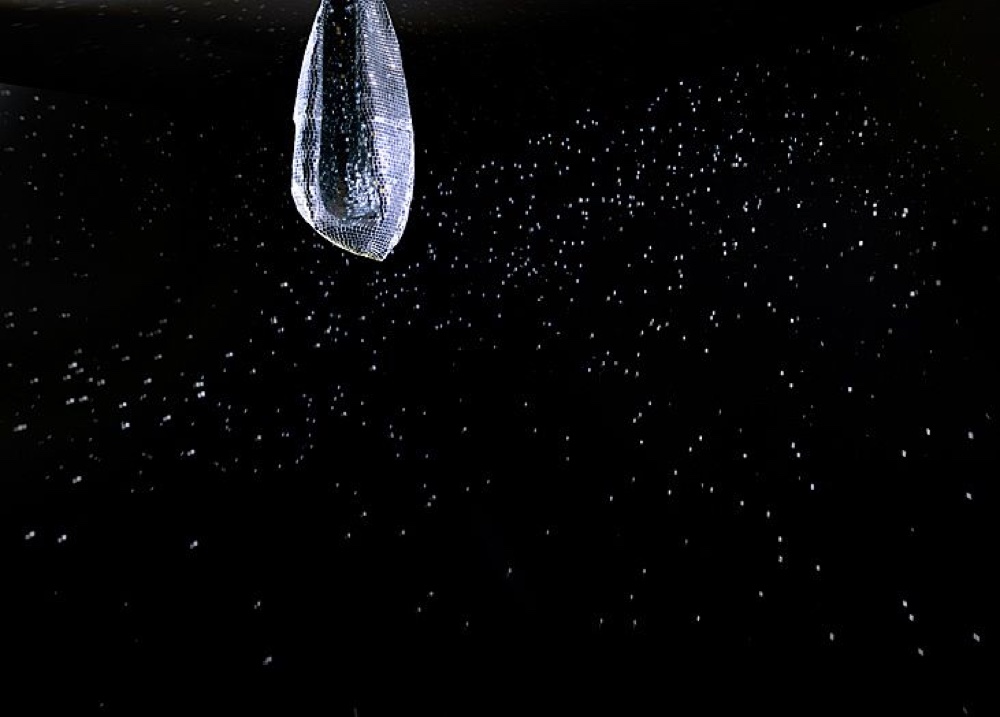
The installation La Boum, 2012, by Marie-Anne Baccichet stages an atmosphere of nostalgia with simple means. A loosely hung ball illuminated by two lamps is attached to the ceiling of the darkened room. In slow rotation it throws spotlight-like marks onto the walls that seem to dissolve the real space through the movement and reflection of the lights on the mirror chips. Like in a dream, we are led to a different location that doesn’t or no longer exists. The title La Boum — the party — plays with this moment of the past. The party is over, the music has stopped, and the people have gone. Another allusion might be the French cult movie La Boum that was very successful in the 1980s, which sensitively treated the trials and tribulations of puberty and had cult status for a whole generation of teenagers. In Marie-Anne Baccichet’s drawings, too, these fragile moments play a big role. In the series of Bigoudi, 2011 or Barba Papa, 2012, for example, she further expands the narrative threads of the protagonists with her pencils and provides her creatures with a new pictorial existence.
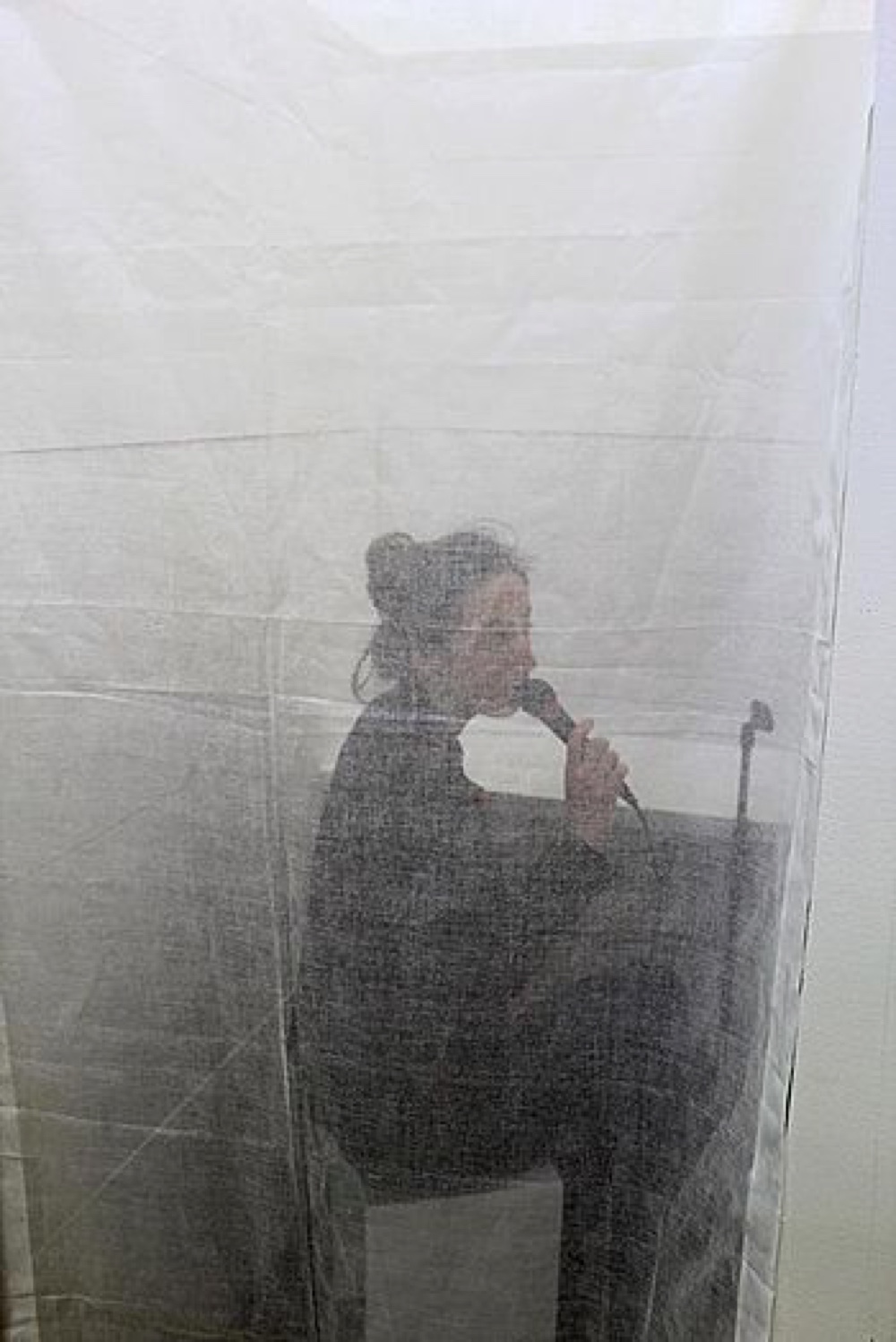
A Word for a Play is a “work in progress” developed by artist Sarah Bernauer and curator Franziska Glozer, in the course of which local and international artists create an audio play in the form of live performances, lectures, spoken acts and audio recordings. It is the attempt to trace language back to its very own properties — speaking, listening, the voice and its expression — and thus get close to the idea of letting language stage itself. A statement for our instrument, language. An experiment to find new forms of expression, quite literally. More information: awordforaplay.le-desir.org
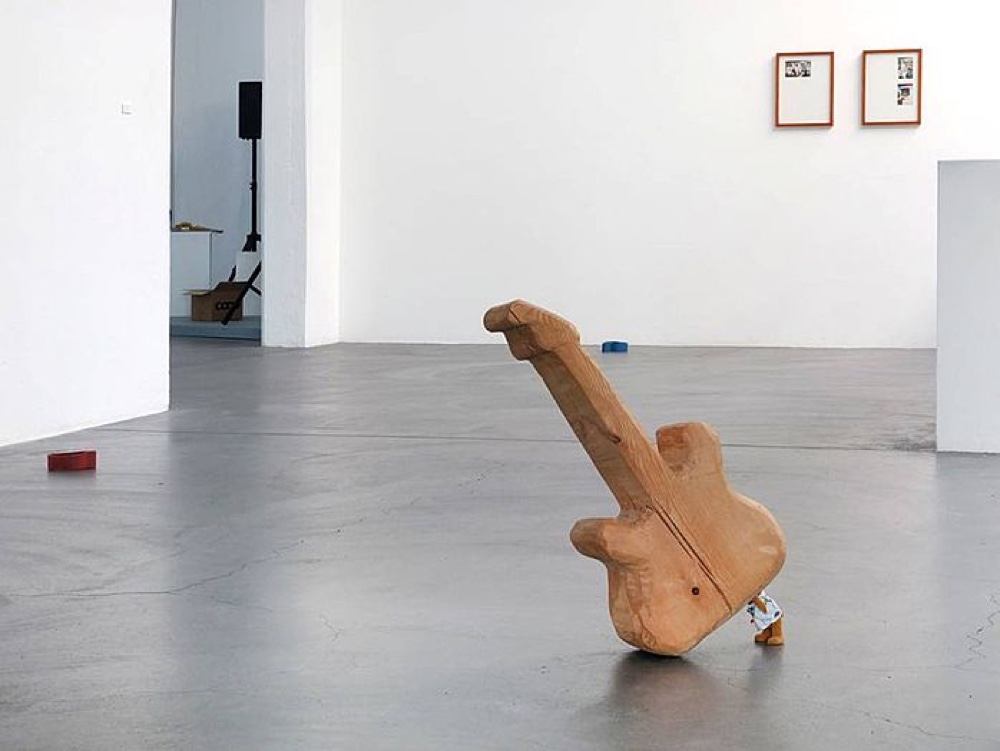
In his installation, Jan Kiefer shows photos of the room of his youth in the late 90s. The period of 80s and 90s was the time of punk culture and resistance, something that also emerges on a small scale on the bedroom wall of the artist. The Fender Stratocaster became a symbol of the rock scene of that time, which even today is still the best-selling guitar in the world. Based on original plans of the Fender Stratocaster, Kiefer has compressed the design drawing by a third. The resulting model was carved from a single log. The guitar is supported by a small Alf in the possession of the artist. Alf, an alien who landed accidentally on earth, is a fantasy figure of the 80s. He became known for his somewhat naive and sympathetic anarchic manner with which he disrupted and at once animated the everyday life of his “foster family”. The installation is completed by several objects, which based on terry headbands, was cut from a solid granite base and then scumbled.

Ralph Bürgin’s paintings form their own narration with space as exhibited in Kunsthaus Baselland. As canvases, they are the bearers of his imagery as well as object-like protagonists in space. “Bürgin’s intuitive workflow stands for that moment of figurativeness, which evolves from the abstractly expressive manner of painting and eventually gets lost in the same again” (Lorenz Wiederkehr). While the focus of his creative work was initially on the issue of development of the figure, in the meantime it has become its reduction. With his works, he experiences a melee in search of vitality, passion and emotionality. He pushes the boundaries of what the paintings can altogether endure and goes so far until, after a prolonged process, the figure opts out and becomes independent. Inconceivable, insecure existences develop that sometimes appear brutal, intrusive, and also grotesque. Stretched skin, underneath which emotions are seething. “Ralph Bürgin fully trusts the effects of the colours and provides them with the potential to touch some of our seemingly extinct archetypes and cravings through the interminable processes of their creation and perishing” (Markus Stegmann).
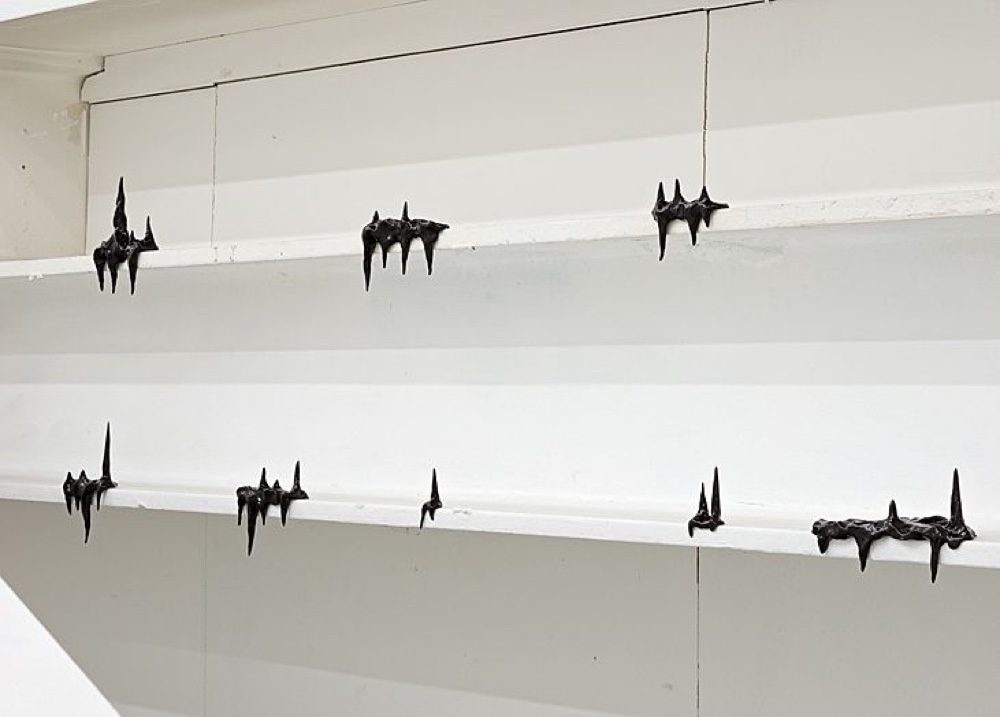
“For the exhibition No man is an island, I decided to show works that were created in the course of this year. Most of them originate from my studio time in Montreal, where I spent the first half of the year as recipient of an iaab scholarship. All works shown have in common some form of or function as ‘patina’, an interest in historicity. Obviously, this antiquisation appears in the Alte Böcke where indeed old material is used. The trestles as dysfunctional commodities also ask about the function of the art work. The crosses in turn evoke the feeling of something historical, reminiscent perhaps of art from the beginning of the 20th century and are drawn by hand in a monastic manner (read meticulously). There is inherent in them a notion of, I think, a religious, spiritual, but also quite political nature. The ‘patina’ also occurs as drawn by wind and weather in the video Gegen die Wand. The political allusion continues here as a ‘fight against the windmills’ but also as a game of attrition. ‘The Wall’ is already an allegory for something relentless, perhaps for a system, and is covered here with a snow action painting barrage. The ‘stalactites’ ultimately are a kind of ‹patina’ in function. They cover architecture or design, but with a very shiny surface.” (Martin Chramosta)
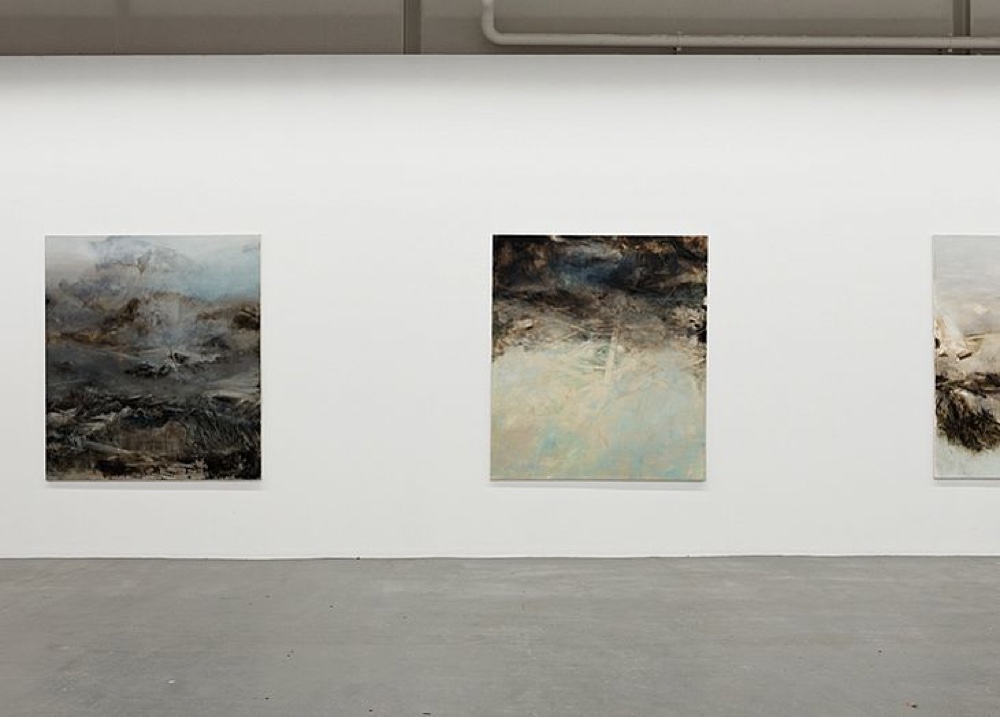
“I am not interested in the self-sustaining and the continuous, but in the ephemeral and changeable, the landscape, as an ever-changing place with all its traces and the time inherent in it. Deserted, as in the process of passive decay and active deconstruction, scenarios emerge in my paintings, which are reminiscent of a previous existence of civilisation. These are fragments from the past, but these remaining fragments also form potential raw material for new buildings. Between decay and development, the visible and the invisible, focus and blur, idyll and abyss, legacies that have not been left by anyone emerge. They are landscapes that have sprung from my imagination or memory, which might actually exist only in their outline.” In her paintings, Lorenza Diaz tries to empty common notions of the landscape which are anchored deeply in our cultural memory and place them in an illusory perspective. The landscapes in her paintings slowly unfold before the eyes of the viewer and in their mysticism rather resemble a hint or a clue which, though barely created, are already poised to evaporate. Using various techniques such as erasing or scratching, washing away and painting over, she creates remote, incredible fantastic fabrications or memory fragments in a tightrope walk between construction and destruction.

“On Jan Erbelding's work von hier aus gesehen oben rechts, 2012, masking tape on wall: «As a vertical line the stripe divides the wall on which it is applied on both sides into two surfaces that drift apart. The rhythm is broken abruptly by the quality of the stripe itself, which remains indifferent and lucid as opposed to a corner, edge or column. The transparency enables the framing of the wall in its entirety as well as that of the surface, whose protection is the membrane of the duct tape, and which it unveils by covering it. The result is an interplay of shape and availability of the wall surface through the picture puzzle of stroke and/or surface and tape. The viewer experiences the work not only due to its property of transparency, emergence and disappearance, but also due to the changing reflection of the light incidence depending on the position, which leaves the duct tape partly invisible in the visual field of the viewer or presents it as a purely white surface. The subtle, consciously guided intervention of the artist in the room as a negative body needs to hold its ground against many objects of artistic or profane nature; this can only succeed if the view of the work itself is reflected by the viewer. In addition to its properties that influence space and perception, the material itself has contents that are inherent to the work. Scotch tape is not as permeable and empty as it apparently pretends to be. Its use as a data carrier is indeed possible. This memory potential of information has an anthropological equivalent in the experience of how people use the tape. When pulling off and sticking it, it often happens that fingerprints become visible and get fixed on the adhesive tape. Transferred onto the work, a ‘fingerprint’ is written onto the tape when peeling it off the wall. The surface of the wall and the underside of the adhesive strip at that moment form an interwoven unit, and in case of a separation, something of it will remain in the other.” (Felix Mittelberger)
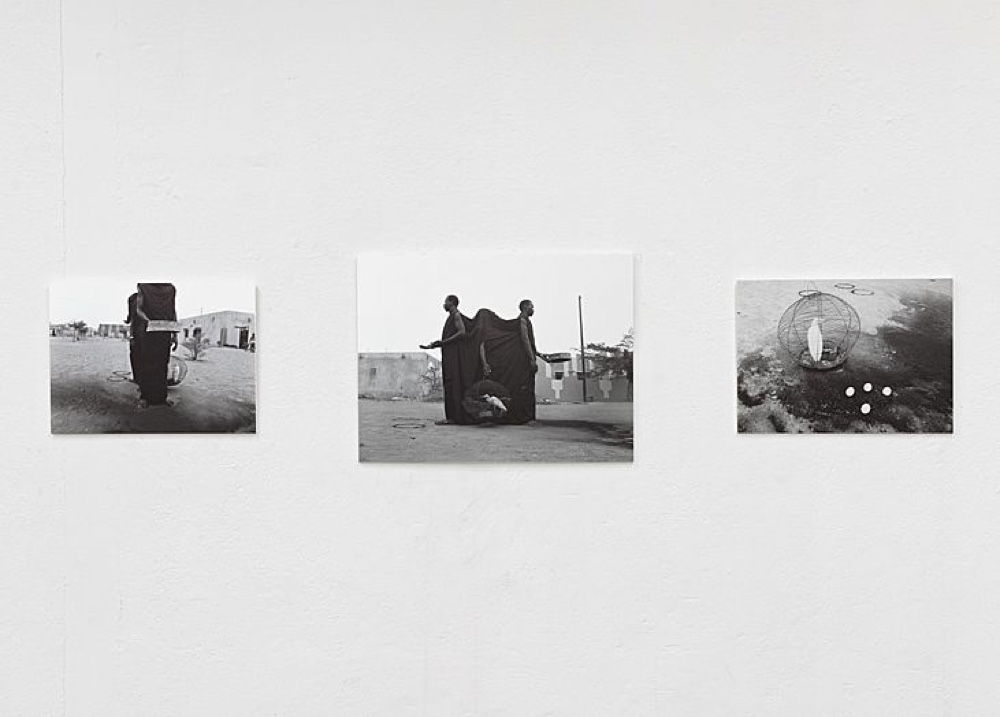
The photographic work of Delphine Gatinois in various ways touches on moments of strangeness. They are staged situations and images that create a tension between the real and the fictitious by confronting the viewer with an exotic setting. The photos were taken in Bamako (Mali) and tell a mysterious story, whose content combines local mythical elements with documentary ones. These are stories in pictures originating from heard narratives, which however allow for their own interpretations and fantastic references.
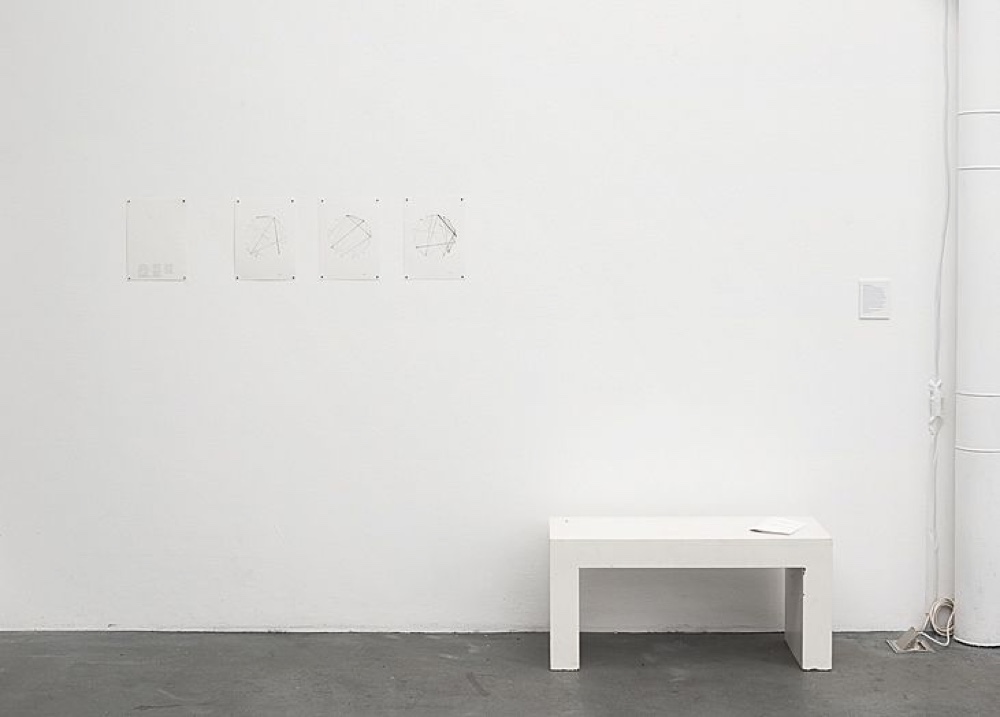
Bianca Hildebrand's Conversation I—III is an audio installation that takes the transcript Artists' Sessions at Studio 35 (1950), a three-day discussion between artists from the circle of abstract expressionists, as the basis for a new version. The sessions of the past have been re-recorded with young art students, who take on the role of the former artists plus the artist herself as a character. The various conversations are played on four speakers in isolated statements, partially ripped apart and repeated. The statements relate to topics that have no clear answers to this day: the role of the artist in society and his community, the question of motivation and anxiety, as well as the cultural differences between Europe and America. The questions and opinions raised in the group are historically autonomous and seek a connection to the present. Three drawings are analogous to the course of the discussion of 1950 that took place in New York. The lines represent the course of the conversation among the 22 participating artists. Each statement is given as a line. A drawing per day plus the list of names moreover provide information on how the artists were originally seated
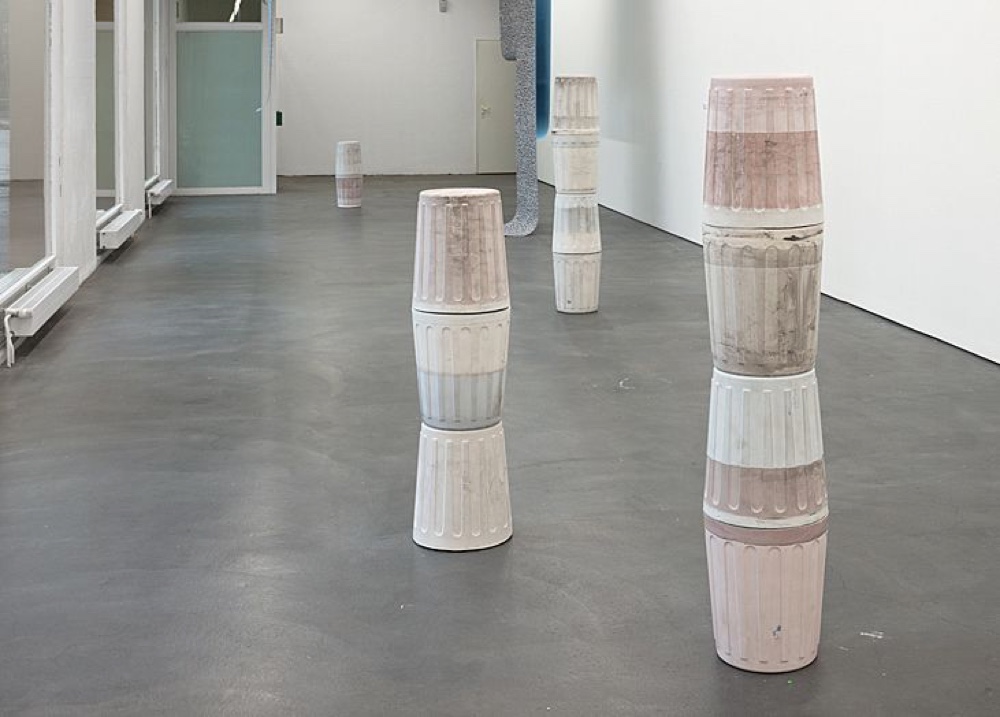
Clare Kenny works with a variety of materials. Apart from building materials or simple, often found objects and elements, photography forms a key point. Kenny subverts a selected photographic image, folds or punches it again for each presentation in an exhibition, or converts it into a sculptural presentation. The installation at the Kunsthaus Baselland does without photography and focuses on a sculptural staging. A variety of plaster casts of the inside of plastic tubs form columnar fragments. The solid, partially coloured plaster parts still bear traces of their forming material. Thus traces or remains of former constituents have been transferred to the sculptural forms – as it were a final citation of a tangible narrative. With her sculptures, Kenny stirs our own memories of building sand castles. Pot over a pot, container over container and an ephemeral object was already finished, until the sea or the wind reclaimed the most primordial of all sculptures. Kenny’s sculptures are of more substantial appearance and piled one above the other, are reminiscent of Brancusi’s Endless Column. Kenny's works are rooted in her personal identity and history and yet include universal statements. They tell of memories, everyday life and longing. In a simple and impressive way they make a connection to art history and art-making in general.
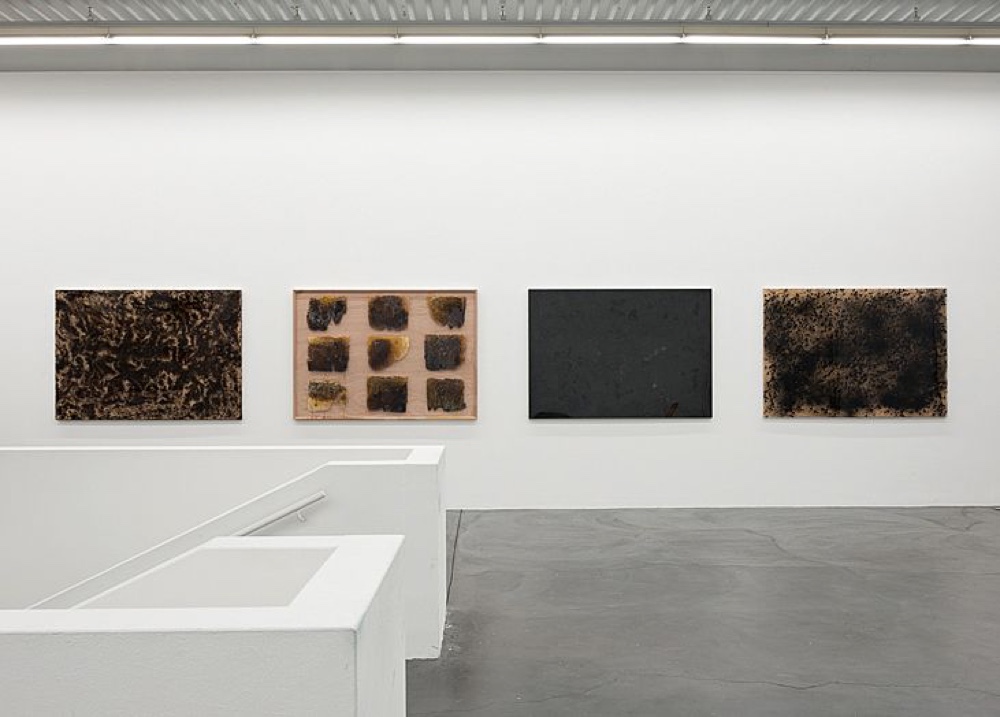
In his four pictures, Oliver Minder unites naturalness with artificiality. The result is a disharmony that evokes a deceptive sense of aesthetics. With the use of toxic polyester resin, Minder can show the natural materials to the viewer in their natural beauty indeed, but at the same time he takes away whatever life is in them by this kind of preservation. Sepia ink, for example, is expelled from squids when in danger. The dark cloud dissolves quickly in water. This volatility cannot be seen anymore in Oliver Minder’s work. In combination with the polyester resin, something new emerges, something that goes beyond the juxtaposition of the two materials. In a second picture, Minder has mixed soil with the resin. If you look closely, besides humus and fallen leaves you'll also see butterflies and beetles. In the other two images, the artist has used honeycombs and coal as natural materials. Both materials have a long cultural history to show and precisely suit Minder’s questions - questions about aesthetics and artificiality and about the consequences of man’s intervention in nature.
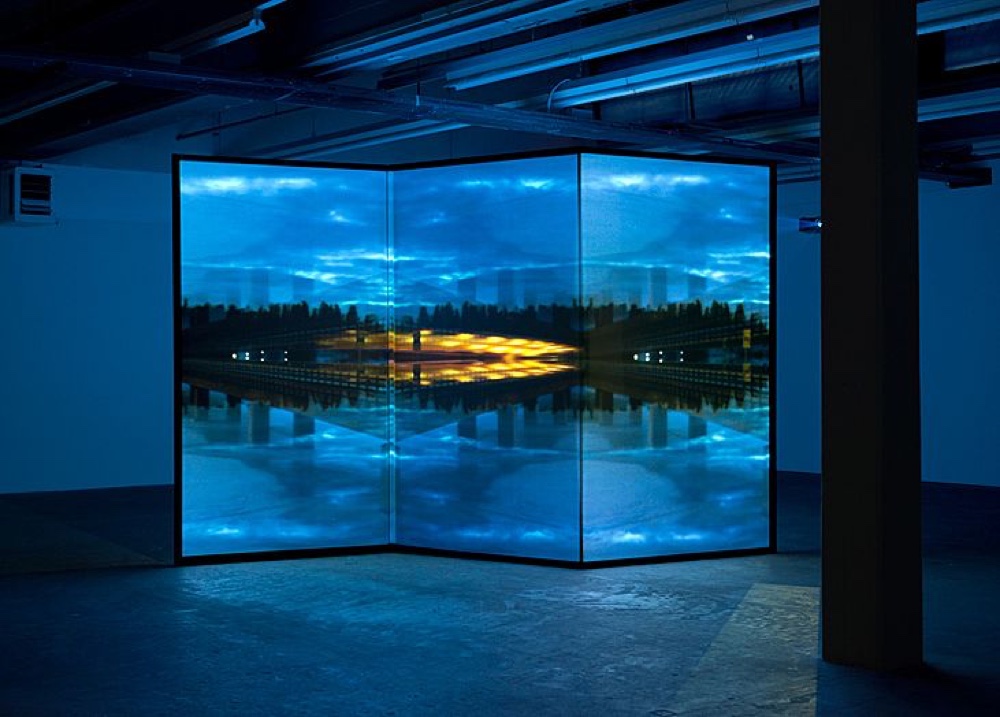
In his installation video work Sebastian Mundwiler deals with the Möbius strip and translates it into the video loop Moebius Metro. This oft-cited phenomenon occurs when you rotate a strip along the longitudinal axis by 180 degrees and join the two ends together. By this artistic process the top and bottom as well as exterior and interior are united into an endless game and a never-ending run. There is a screen covered with projection film in the middle of the dark room. The video is projected on the screen from two sides on three surfaces. The viewers cast shadows alternately on the projections that are visible on both sides, and are thus part of the walk-around installation. The video shows a cold, atmospheric landscape with a bridge in Helsinki. The darkness of night is penetrated only by the warm light of the passing metro. The projection confuses the perception of the viewer through horizontal and vertical reflections. They lead to an initial disorientation, in which the top and bottom, left and right, are dissolved.
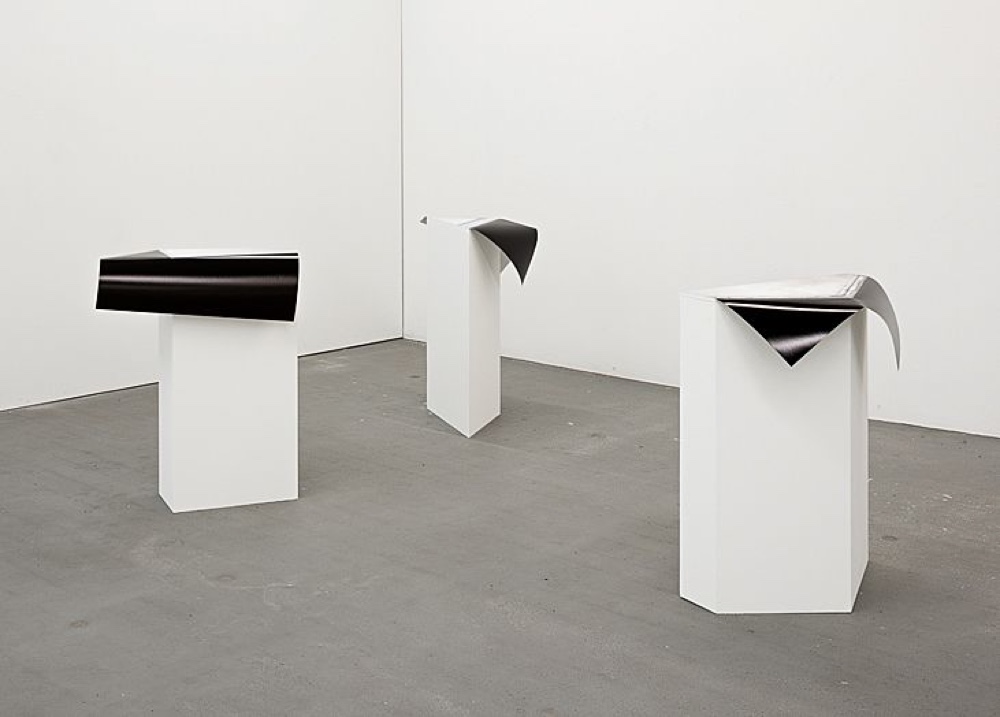
With her installation work, Landowski, 2012, Bianca Pedrina plays with the perception of image and space, as well as with the physical presence of the object and the viewer. During her stay in Paris, Bianca Pedrina regularly encountered the statue of Sainte Geneviève, the patron saint of Paris, of the sculptor Paul Landowski. At the Regionale ‘13 at Kunsthaus Baselland, she exhibits a photographic image of the back side of the statue’s pedestal. A plastic panel fixed between two steel beams supports the photograph. Due to the backward curvature and the two lateral supports a perspective view emerges which directly coalesces with the ceiling of the room. By alienating the back of a statue photographed from the bottom up, Bianca Pedrina shifts the viewer’s perspective to eye level. The work White Sharks, 2012, shows three photographs of balcony soffits, which are mounted on pedestals. Like the dorsal fins of white sharks, the bright areas stand out from the black. The pedestals become apparent under the bright areas, while the black areas droop down and thus reach into the room. Like the emerging dorsal fin of the shark under the water surface, the images suggest spaces where there are none.
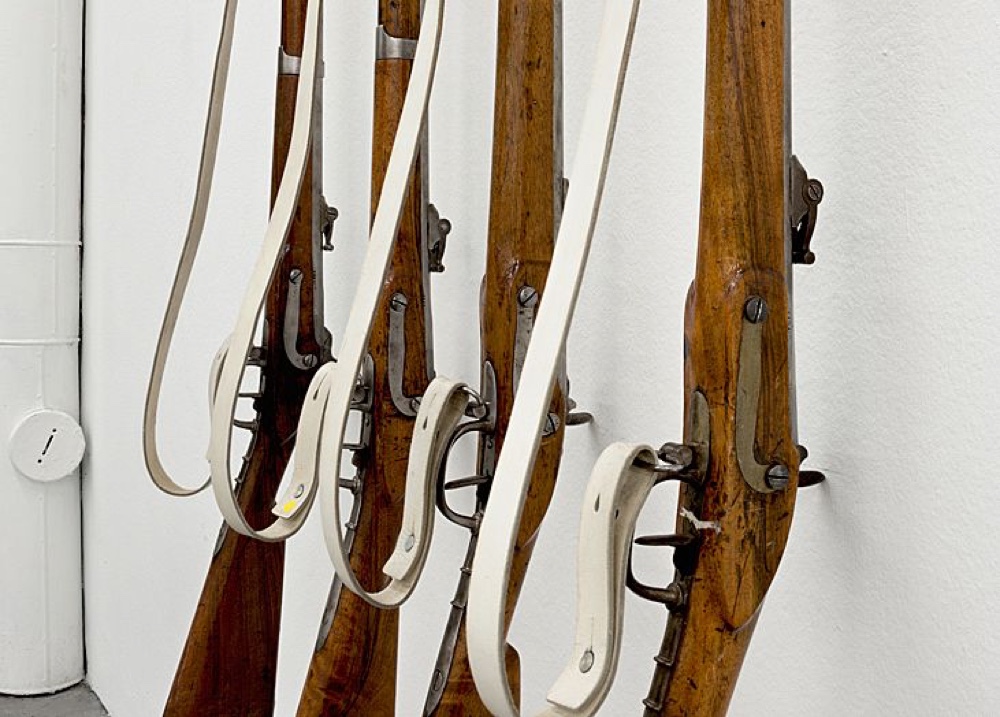
In his work Nachhall, 2012, Philippe Reinau deals with the history of the site-specific “Joggeli”, where Kunsthaus Baselland is located. At the opening, soldiers dressed in historic uniforms take up positions in the entrance area. The relics of this unique performance are represented by the remaining historic weapons, which will be wall mounted in the entrance area during the entire duration of the exhibition. With Nachhall, Reinau translates in terms of both performance and installation, a historically contentious incident into the present, which still bears the historical traces.
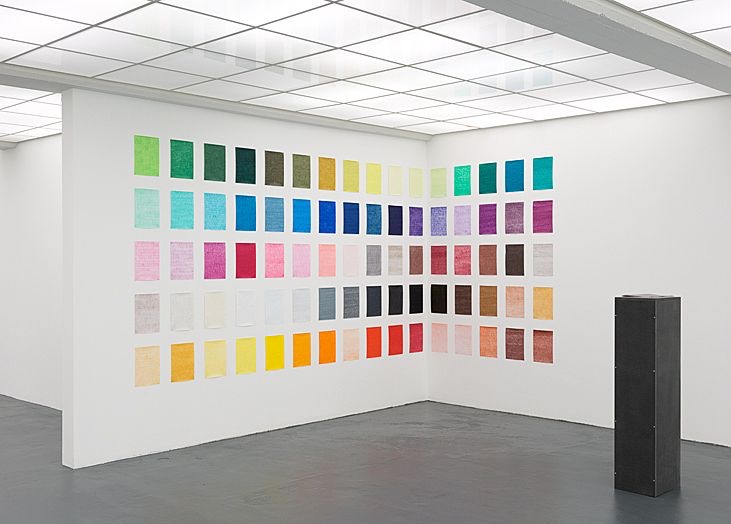
The works of Marion Ritzmann at Regionale‘13 deal with moments and interactions in between them. In her actions, the moments of production and reception shift, while the action itself reflects or rather receives the production. This is shown in the work Round about machine, wherein a mounted pencil leaves a trail, which on the other side is immediately erased again by an electric eraser. The piece of paper stretched around a cylinder simultaneously becomes connection, carrier and the actual player by means of a kinetic mechanism. The slow rotation reinforces the question: who or what records all this here? Where does the drawing end, where does it start? The actual action of the Round about machineseems pointless, we think only of the continuous creation of a line that is immediately erased again. The set of rules may, however, bring about changes, and every drawing that is created by the interaction between the pen and eraser leaves behind its uniqueness. In the work 80 colour pencils, the properties of pen, paper and eraser focus on the use, benefit or wearing out. The 80 colour pencils mounted on the wall in rank and file allow conclusions to be drawn about the variable handling due to their different lengths. At the same time they point to the 80 A4 sheets, which vary in their different processing, printing quality and stroke length. They in turn refer to the use of pens. The publication in booklet form, in which all the pages are seen next to and behind each other, shows the real attraction of the work; the transformation of an original object. In this case, a box with 80 colour pens.
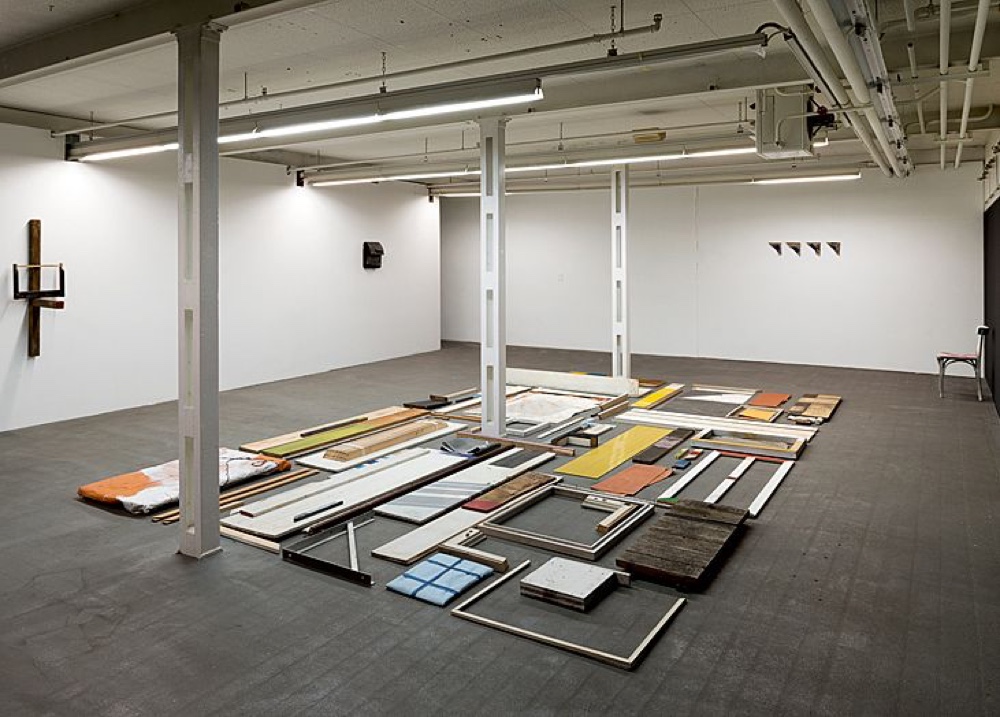
Tom Senn describes himself as a painter of “classical“ origin and places his ‘pictures’ in the room through installations. However, he does not work with paints and brushes on a canvas, but renders the painting in real space. Senn questioned the illusionistic space in the two-dimensional image and gradually relinquished the traditional image carrier. Nevertheless, painting influences his artistic creation and ideas. Prior to the exhibition No man is an island Senn put together a colour palette from found objects, which he then put in the limelight in a site-specific manner. Senn sees himself as a collector and translator. In his work, contrasts, paraphrases and transfers play an important role. The artist himself is the brush, his found objects turn into paint and the room becomes the image carrier.
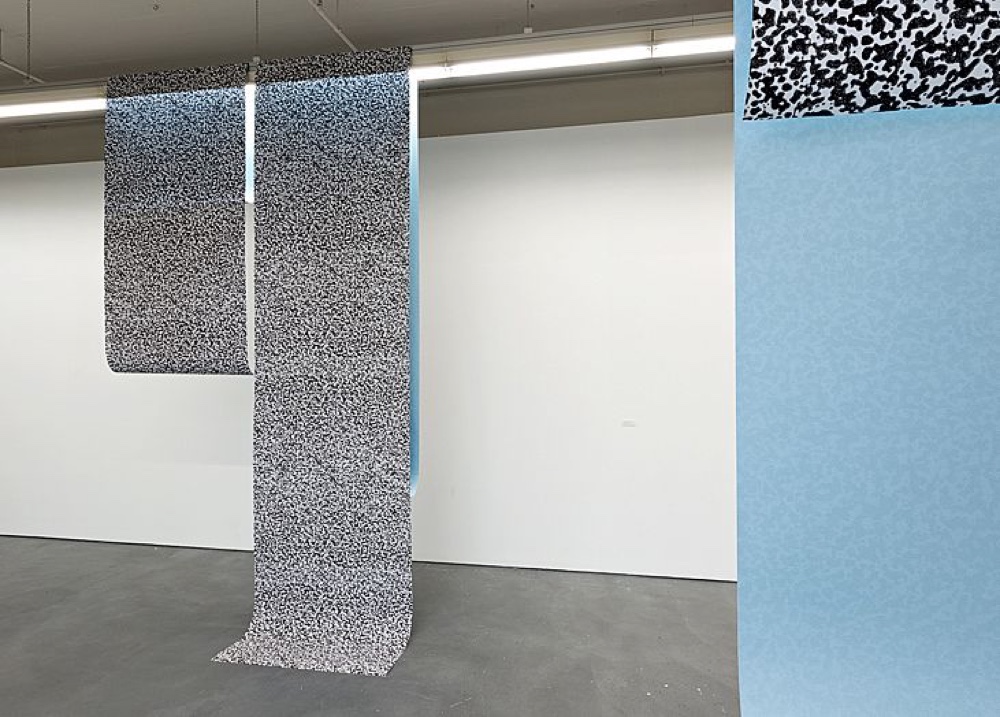
“The conceptual background of Wallpaper lies in my general examination of painting. And I’m always thinking about the significance of painting. Because, it quite often degenerates into a decorative element, to complete an interior, to adorn a wall, sometimes alone, sometimes with too many others… On another level, I am, of course, also interested in one of the classic themes of painting: foreground vs. background. I find this situation in patterns, which shift between levels, break up the depth of the image and are also a constant repetition. From there the idea of a wallpaper is not far behind. As a final flattening of painting and the coming together of image carrier and wall. In the work Wallpaper I'm also interested in the moment of surface and objectness or rather its transfer. Therefore, it is my concern not just to paste the work on the wall as it would be self-evident, but to install it three-dimensionally. The title Wallpaper thereby is a reference to the functional context, but the work is detached from it due to the type of installation. The pattern used is an adaptation of a design encountered in an everyday context, but it has been modified and enlarged by me, transferred to a fresh pattern repeat and printed on lengths of paper” (Valentina Stieger).
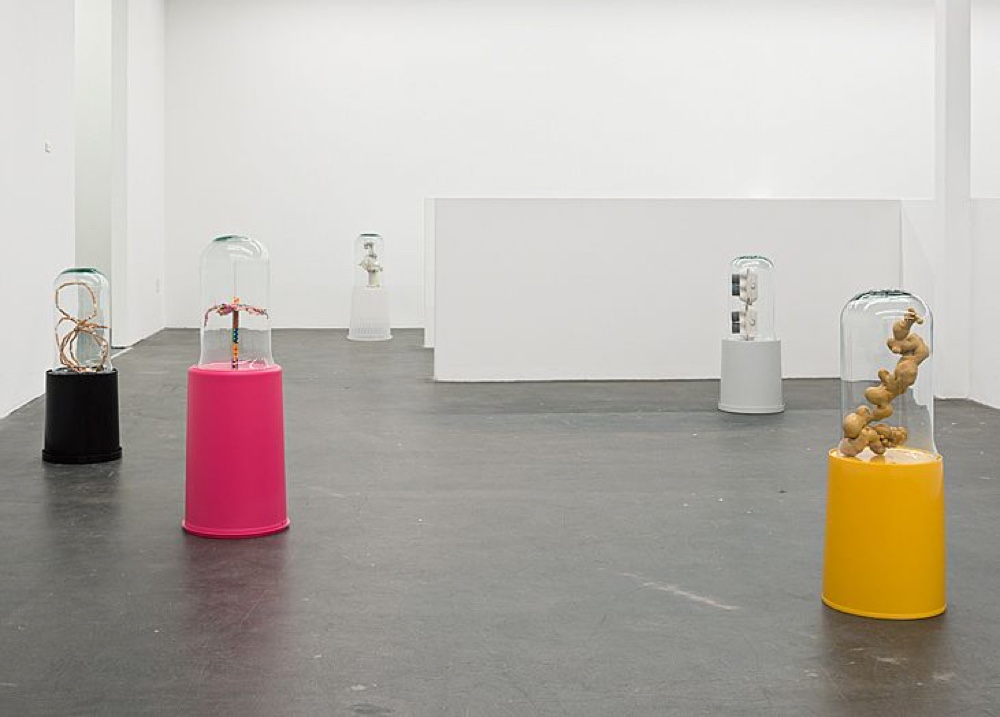
In the exhibition in Kunsthaus Baselland, Aline Zeltner displays three different new works. Her large purple book Wohin gehst du? (2012) is installed on a yellow pedestal inside of the lift car. In the course of several months Aline Zeltner captured and collected fleeting moments of encounter at different locations and in different moods. She photographed people from behind as they walked, immortalised these found moments and thus slowed them down. That moment of discovery is also inherent in the seven objects of Ohne Titel (2012). She has installed them on coloured waste bins placed upside down, which become pedestals for small, fragile sculptures made of waste. Carefully protected by a glass cover, they invite the viewer to engage with them. Mach mal einen Punkt (2012), is a mural consisting of four placard parts that Zeltner pasted on the wall intentionally amateurishly. The printed red dot is a photographic reproduction of a small hand-painted dot, which vividly demonstrates the difficulty of making a point.
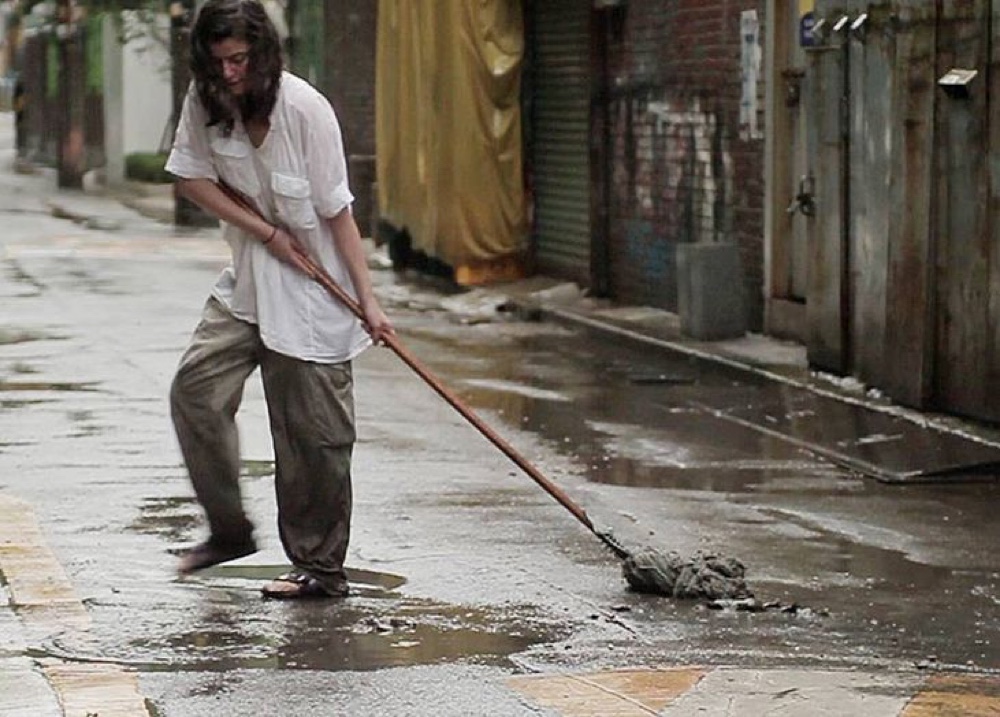
Curated by Sophie Kauffenstein, Accélerateur de particule, Strasbourg:
Natacha Paganelli
Dans les rues de Séoul en Corée une femme (l’artiste) tente de balayer la pluie. Geste frénétique, danse…?

Curated by Sophie Kauffenstein, Accélerateur de particule, Strasbourg:
Gregory Buchert
Plus de 20 ans après la disparition de son père, Gregory Buchert choisit de rejouer un étrange souvenir d'enfance afin de comprendre les causes de son départ. Soit: un fils tentant de battre un énigmatique record paternel, en lisant Ulysse de James Joyce, dans un camping-car filant vers le sud de l'Europe.

Curated by Sophie Kauffenstein, Accélerateur de particule, Strasbourg:
Antoine Lejolivet
De la lumiere, un paysage, encore de la lumière, un autre paysage, beaucoup de lumière et toujours ce personnage, comme un observateur qui voyage dans des espaces temporels, sonores et linguistiques multiples. Un “trou de ver” est un tunnel théorique, le passage vers une fontaine blanche; une possible téléportation?